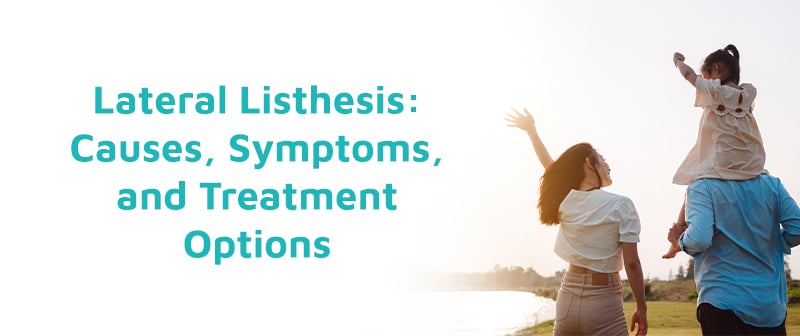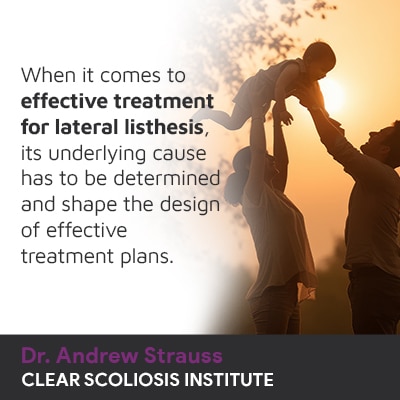
In a healthy spine, when viewed from the side, its vertebrae are stacked on top of one another in a neutral and straight alignment, and this allows the spine to maintain its natural and healthy curves, which facilitates its optimal health, strength, and function.
There are many spinal conditions a person can be diagnosed with, and one that adult patients hear frequently, but don’t fully understand, is lateral listhesis. A diagnosis of lateral listhesis is given when a vertebral body has slipped off another in the axial and coronal planes.
Let’s start discussing lateral listhesis by first exploring some basic spinal anatomy.
Healthy spines are naturally curved at each of the main spinal sections: cervical (neck), thoracic (middle/upper back), and lumbar (lower back).
The spine’s natural/healthy curves make it stronger, more flexible, and facilitates the even distribution of mechanical stress incurred during activity.
As mentioned, the spine consists of vertebrae (bones) stacked on top of one another, and adjacent vertebrae are separated by an intervertebral disc.
The intervertebral discs are key to the spine’s health and function as they provide cushioning between vertebrae (preventing friction), structure (adjacent vertebrae attach to the disc in between), spinal flexibility, and act as the spine’s shock absorbers.
Many spinal conditions are closely tied to disc health, and if the spine becomes misaligned, meaning one or more vertebral bodies have shifted out of alignment with the rest of the spine, this can cause a number of issues.
So what is lateral listhesis: a spinal condition that involves a vertebra slipping sideways as it rotates away from its normal position and alignment with the spinal bones next to it.
So the spinal misalignment has a rotational component, and now that we’ve defined lateral listhesis, let’s address some of its common causes.
Lateral listhesis is most prevalent in adults 50 and older as age-related spinal degeneration can cause the level of spinal joint instability capable of causing lateral listhesis; it is also more prevalent in women, and this is due to hormonal and bone-density changes associated with menopause.
In addition, conditions like degenerative scoliosis, particularly when severe, introduce uneven forces to the spine, and those uneven forces can increase rates of spinal degeneration.
Degenerative scoliosis is linked with degenerative disc disease, failure of the spine’s stabilizing joints, and as the spine’s supportive ligaments have to work harder to compensate for the failing facet joints, the ligaments become thicker, less supportive, and can increase spinal misalignment.
Scoliosis is the development of an unnatural sideways spinal curve, with rotation, meaning the spine both bends unnaturally to the side, and also twists (rotational component).
If the level of spinal arthritis has caused the onset of degenerative scoliosis, adults can experience enough joint instability to cause the related complication of a vertebra shifting sideways: lateral listhesis.
While not all cases of adult scoliosis are guaranteed to degenerate into lateral listhesis, it is a common complication of the type of scoliosis that starts around 50 years of age, particularly in women, when severe, and/or if left untreated.
In fact, one study found that in patients with scoliosis, approximately 44 percent had a related slippage of the spinal bones (lateral listhesis), whereas only 3.8 percent of people without scoliosis had a similar slippage.
When a vertebra slips to the side, the spine’s overall strength and function are affected, sometimes referred to as segmental instability.
Healthy vertebrae are rectangular in shape so they can be easily stacked on top of one another.
Picture a row of dominoes stacked vertically: what would happen to the row’s structural integrity if one of those dominoes shifted out of alignment with the rest by slipping to the side or twisting away from its alignment? The whole row becomes less stable, and not just the one section with the sideways slippage.
Lateral listhesis is most commonly diagnosed in the lumbar spine, and while each spinal section has to work hard it its own way, the lumbar spine has the added responsibility of supporting the weight of the entire trunk, the spinal sections above, and the lower back also feels the effects of bending, lifting, and twisting motions.
Spinal arthritis can lead to a number of spinal conditions/issues, and as mentioned, it’s often the spine’s cushioningl discs that are the first spinal structures to start deteriorating, and this is due to the many important roles they play in maintaining spinal health and function (discussed earlier).
When a spinal disc starts to weaken due to stresses of aging, it loses tension, and this can cause the disc to bulge outwards, which increases the level of movement between the vertebrae (spinal joint instability).
An arthritic disc tends to lose height, changing its shape, which affects the position of its fellow spinal bones that attach to the disc in between; this can cause the spine’s stabilizing joints to shift out of alignment.
The spine’s stabilizing joints are like hinges connecting the bones of the spine (vertebrae), and they also help to give the spine flexible bending and twisting motion, while preventing the back from slipping forward and/or twisting too much.
A twisted or crooked spine is one that’s not going to function optimally as the normal movement of the spine is disrupted, and the uneven forces lead to uneven wear and arthritis.
If the spine’s structures start to break down, various kinds of instability can develop, and based on the direction and location of the instability, the misalignment can cause different types of slippage: spondylolisthesis (vertebra slipping forward), retrolisthesis (vertebra slipping backward), olisthesis (vertebra twisting out of position) and lateral listhesis.
So now that we’ve defined the condition, plus explored some of its common causes, what are some symptoms associated with lateral listhesis?
Thoracolumbar scoliosis (a combined scoliosis that involves both the lower trunk part of the spine and upper part of the lower back) is the most likely curvature type to cause lateral listhesis in adulthood, and this is known to cause varying levels of back pain.
When scoliosis is the underlying cause of a lateral listhesis, the more severe the scoliosis, the more likely it is to cause the level of joint instability necessary for a spinal bone to experience sideways slippage.

Lateral listhesis symptoms will be shaped by its underlying cause; when that cause is scoliosis, postural deviation/collapse, localized back pain, and radiating pain due to nerve compression (more common in adults) are typical.
When general spinal/disc degeneration is the cause, back and nerve pain can be an issue, and the area of the body most closely located to the affected area of the spine is the most likely to experience its direct effects.
Nerve pain and discomfort can be felt anywhere along an affected nerve’s pathway, so if a vertebra has shifted sideways and is encroaching on the space used by spinal nerves, nerve compression can occur; nerve compression can cause pain, tingling, numbness, electric shock-like sensations, weakness, and a variety of symptoms felt throughout the body.
When a section of the spine has deteriorated and experienced lateral listhesis, its surrounding ligaments, muscles, and nerves are also affected, and postural changes (postural collapse) and a loss of height can be a symptom as it becomes increasingly difficult to maintain healthy posture/stand up straight due to the spine no longer being aligned.

So if degenerative scoliosis is determined as the cause of the vertebral slippage, the scoliosis itself has to be treated proactively so the condition’s uneven forces are reduced alongside the size of the unnatural spinal curve, taking pressure off the spine and its individual parts; this is worked towards through condition-specific chiropractic care.
Scoliosis-friendly exercises aimed at core strengthening are also important for increasing core strength so the spine’s supportive ligaments and muscles are strengthened and can provide the spine with optimal support.
As adult scoliosis progresses, the use of scoliosis-specific exercises (SSEs) is key to regaining stability, spinal support, and recovering a degree of postural collapse; of course, improving scoliosis doesn’t mean reversing degeneration that’s already occurred (these changes tend to take place slowly over time), but making improvements to posture can address postural imbalance, reducing uneven pressure exposed to the spine, and can help slow rates of spinal degeneration.
When general spinal/disc degeneration is determined to be the cause of lateral listhesis, treatment options also include chiropractic care and variousl therapies
Chiropractic care can work towards addressing areas of spinal misalignment and restricted movment of the spinal bones through a series of chiropractic techniques and manual adjustments that can realign the spine by repositioning specific spinal bones to their normal movement and position.
Chiropractic care can also help with taking pressure off certain spinal structures, improving disc health and function by increasing circulation around affected discs.
Scoliosis-friendly therapy and a variety of specific exercises can be used to increase core strength so the spine is better supported and stabilized by its surrounding muscles, and certain condition-specific exercises can also activate areas of the brain for enhanced brain-body communication, postural correction, and better body-positioning.
While there are surgical options for addressing spinal conditions like lateral listhesis, this option is generally reserved for the most-severe cases, and Keep in mind that spinal surgery is costly, invasive, and tends to come with some serious potential risks, side effects, and complications, and those risks only increase with age.
In order for the spine to maintain its optimal health, strength, and function, its natural curves and alignment need to be in place.
A spine that’s aligned has its vertebrae stacked on top of one another in a straight and natural alignment, but if one or more vertebrae shift out of alignment with the rest of the spine, its entire biomechanics are disrupted, which can lead to a number of spinal conditions/issues.
There are different ways a vertebra can slip out of alignment. and lateral listhesis refers to when a vertebra slips off another by shifting sideways and rotating.
Patients with arthritis caused by scoliosis have a certain level of spinal instability due to deterioration the spine has already experienced, and lateral listhesis can be a common complication due to the nature of age-related spinal degeneration increasing over time, plus the progressive nature of scoliosis.
When caused by general spinal deterioration, this is often the result of degenerative disc disease as once a disc starts to degenerate, it tends to become desiccated and change shape, affecting the spine’s structure as adjacent vertebrae attach to the disc in between.
As a CLEAR-advanced fellow, I’ve treated a large variety of spinal conditions, particularly those with a strong connection to scoliosis, lateral listhesis included.
Treatment options for lateral listhesis will depend on the case in question as the underlying cause of the spinal joint instability has to be addressed, and this can involve a combination of condition-specific chiropractic care and scoliosis-oriented therapy; these treatment disciplines can complement one another by addressing areas of vertebral subluxation while improving core strength so the spine is optimally supported and stabilized by its surrounding muscles

CLEAR provides a unique and innovative way of understanding scoliosis. Sign up to receive facts and information you won’t find anywhere else.
